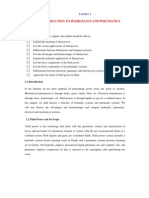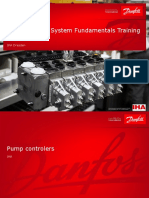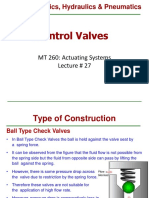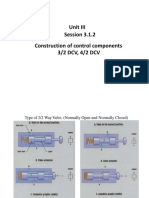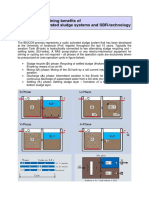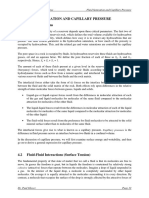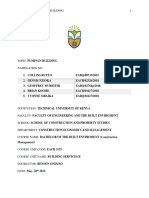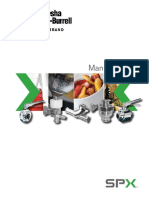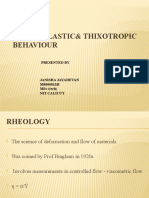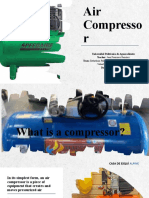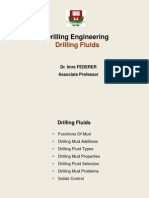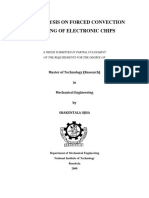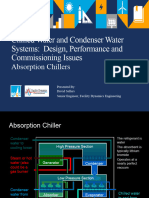Chapter 4 Valves
HYDRAULIC AND PNEUMATIC
Type of Valves
FCV DCV
Output
Control
PCV
Power Supply
�HYDRAULIC AND PNEUMATIC
Type of Valves
�HYDRAULIC AND PNEUMATIC Directional Control Valve : Check valve
Basic DCV is A Check valve. A Check Valve allows flow in one direction. The diagram show a basic inline check valve.
Free-flow direction
No-flow direction
�HYDRAULIC AND PNEUMATIC Directional Control Valve : Check valve
Free-flow direction
No-flow direction
In the free-flow direction, the fluid pressure overcomes the spring forces. The higher the pressure, the greater will be the force pushing the poppet against it seat If flow is attempted in the opposite direction, the fluid pressure pushes the poppet (along with the spring force) in the close position.
�HYDRAULIC AND PNEUMATIC Check Valves in Circuit
�Question :
A pressure relief valve has a 4.2 cm2 area of poppet on which the system pressure acts. A spring which is initially compressed 0.5 cm from its free length condition, has a constant of 3200N/cm is holding the poppet against it seat. The full flow can be achieved when the poppet is moved 0.3 cm from the initial fully closed condition. Calculate the cracking pressure and full flow pressure of the valve.
�HYDRAULIC AND PNEUMATIC Bypassing using Check valve
A Check Valve can be used for component bypass, since it give the circuit line the lowest resistance to the line. Check valve = Injap sehala
�HYDRAULIC AND PNEUMATIC Pilot check valve
Another type of Check Valve is pilot to open check valve. The pilot line refers to a line where it received command from the fluid itself. It always permits free flow in one direction but permits flow in the normally blocked opposite direction only if pilot pressure is applied at the pilot pressure port of the valve. Pilot to Open Check Valve = Injap sehala buka kendalian pandu. Pilot to close check valve will block the free flow if the pilot pressure is applied.
�HYDRAULIC AND PNEUMATIC Pilot to Open Check Valve in Counterbalance Circuit.
What happened if the NORMAL check valve is used or without check valve?
�HYDRAULIC AND PNEUMATIC Pilot to Open Check Valve in Counterbalance Circuit.
�HYDRAULIC AND PNEUMATIC
Shuttle Valve
Shuttle Valve allow two alternated flow to be connected into the line.
�HYDRAULIC AND PNEUMATIC DCV Valves : How to Classified?
In Short : 2/2 DCV, 2/2 Way Valve. In Full : 2 Way, 2 Spool Position Valve.
�HYDRAULIC AND PNEUMATIC Type of 2/2 Way Valve. (Normally Open and Normally Closed)
2/2 Way Valve (Normally Close) type
2/2 Way Valve (Normally Open) type
�HYDRAULIC AND PNEUMATIC Type of 3/2 Way Valve. (Normally Open and Normally Closed)
3/2 Way Valve (Normally Open) type
3/2 Way Valve (Normally Closed) type
�HYDRAULIC AND PNEUMATIC 3/2 Valve (Normally Closed)
Use for single acting cylinder
NORMAL POSITION
ACTUATED
�HYDRAULIC AND PNEUMATIC 3/2 Valve (Normally Closed )
NORMAL POSITION ACTUATED
�HYDRAULIC AND PNEUMATIC 4/2 Valve (PB Type )
�HYDRAULIC AND PNEUMATIC 4/2 Valve (Lever type ) NORMAL POSITION
Use for double acting cylinder
�HYDRAULIC AND PNEUMATIC 4/2 Valve (Lever type ) ACTUATED
�HYDRAULIC AND PNEUMATIC NEUTRAL POSITION
The four way, two position DCV used in previous circuit are sometime impractical since they continuously sending flow and pressure into hydraulic actuator. The should give a relief to the actuator, a NEUTRAL position should be used, where the actuator is not subjected to pump pressure.
4/2 Valve
4/3 Valve
�HYDRAULIC AND PNEUMATIC 4/3 Valve With Closed Neutral Position
Closed Neutral Position: (1) The Pump is blocked. (2) The flow goes to Pressure Relief Valve. (3) The maximum allowed pressure of the system is set by the pressure relief valve.
�HYDRAULIC AND PNEUMATIC 4/3 Valve With Tandem Neutral Position
Tandem Neutral Position: (1) A desirable condition where the only pressure involve line resistance. (2) The power consumption is reduced. Is said to be UNLOADED. (3) Less energy wasted.
�HYDRAULIC AND PNEUMATIC 4/3 Valve With Float Neutral Position
Float Neutral Position:
(1) A desirable condition for a circuit with motor, since it allow the motor to spin until fully stop. (2) This condition is said to allow the motor to float or spin freely without influence of pump. (3) Not using it may caused pressure increase at the motor, since spinning motor might give a resistance when the positioned is changed.
�HYDRAULIC AND PNEUMATIC 4/3 Valve With Open Neutral Position
Open Neutral Position:
(1) A combination of a tandem and float neutral position. (2) A flow will return to the tank from the pump. (3) At the same time, A bit of flow might still be flowing (floating) at the actuator.
�HYDRAULIC AND PNEUMATIC 4/3 Valve With Regenerative Neutral Position
Regenerative Neutral Position: (1) A term used where the flow returning from actuator is feed back into the pressure line to give supplemental power.
�HYDRAULIC AND PNEUMATIC Valve Actuated: Direct and Pilot
Push button 4/2 way directional control valve with spring return
Hydraulic oil in Pilot Line only help in changing the position of the valve, it does not get mixed with the oil that is flowing inside the valve.
Pilot 3/2 way directional control valve with spring return
�DCVs Actuation and Return
Actuation: To switch position. Return : To switch back to initial condition.
�HYDRAULIC AND PNEUMATIC The way to actuate the Valves.
Lever
�HYDRAULIC AND PNEUMATIC The way to the actuated valve RETURN to normal position.
�HYDRAULIC AND PNEUMATIC Example of Directional Control Valve.
�Flow Control Valves
�Flow Control Valve
Main purpose : to regulate speed. All FCVs control cylinder speed by regulating the flow rate. Can be of:
Fixed Orifice and Restrictor Adjustable Orifice and Adjustable Restrictor Pressure compensated and Non pressure compensated valve. One-way flow control valve. Deceleration valve. Flow Dividers Proportional Flow control valves.
�Fixed Orifice and Restrictor
Fixed orifice : provided fixed / constant flow control which is NOT influenced by the fluid viscosity.
Fixed restrictor : provided fixed / constant flow control which is influenced by the fluid viscosity.
�HYDRAULIC AND PNEUMATIC
FLOW CONTROL VALVE : Needle valve.
Basic FCV is a needle valve. A needle valve control the flow rate in the circuit. By controlling the flow rate, the speed of the actuator can be controlled. Controlling the flow rate is called metering the flow, in hydraulics.
�Variable Orifice and Restrictor (Needle Valve)
Variable orifice : provided flexible flow control which is NOT influenced by the fluid viscosity. Variable restrictor : provided flexible flow control which is influenced by the fluid viscosity.
�Pressure and Non-pressure Compensated FCV
Non-pressure compensated FCV : useful when the load is constant. Only suitable for a constant system pressures If pressure changes, speed and flow rate changes. Pressure compensated FCV : useful for variable loading. Always maintain the flow rate and the speed if pressure changes.
�HYDRAULIC AND PNEUMATIC
FLOW CONTROL VALVE : One way FCV
A one way FCV is an integrated needle valve with a check valve. A one way FCV give a controlled flow direction from left to right (A) and a free flow in reverse (B)
�HYDRAULIC AND PNEUMATIC
Meter-In : Controlling the Flow into the Actuator (In case of extension only)
The term meter-in or metering in means that we are controlling the flow that goes INTO the cylinder. The Figure show meter-in flow control during extension only. The meter-in here is only for extension of the cylinder. Remember that that is no metering / no flow control is done on the retraction of the cylinder.
�HYDRAULIC AND PNEUMATIC
Meter-In : Controlling the Flow into the Actuator (In case of retraction only)
Remember that in this case, no metering / no flow control is done on the extension of the cylinder. The Figure show meter-in flow control during retraction only. The meter-in here is only for retraction of the cylinder.
�HYDRAULIC AND PNEUMATIC
Meter-Out : Controlling the Flow out from the Actuator (In case of extension only)
The term meter-out or metering-out means that we are controlling the flow that goes OUT FROM the cylinder. The Figure show meter-out flow control during extension only. The meter-out here is only for extension of the cylinder. Remember that that is no metering / no flow control is done on the retraction of the cylinder.
�HYDRAULIC AND PNEUMATIC
Meter-Out : Controlling the Flow out from the Actuator (In case of retraction only)
Remember that in this case, no metering / no flow control is done on the extension of the cylinder. The Figure show meter-out flow control during retraction only. The meter-out here is only for retraction of the cylinder.
�HYDRAULIC AND PNEUMATIC When to use Meter-In and Meter out ??
It usually depends on the load. When we handle resistive load, we can use Meter In. Resistive load is the load that resist the oil flow. When we handle tractive load, we can use Meter Out. Tractive load is the load that follow the oil flow.
Resistive Load
Tractive Load
�HYDRAULIC AND PNEUMATIC Consequence of Metering in and out.
Pressure intensification.
There is no consequence of using meter in flow control for resistive load. However, by using meter-out for tractive load can cause pressure intensification. This pressure intensification is ok if it within the operating pressure limit of the actuator, if it is out of the operating pressure limit, the actuator can be damaged/break /leak. REMEMBER!!!! The positioning of metering in or out is also differ with the position of the load, whether towards upward, downwards or in horizontal movement.
�HYDRAULIC AND PNEUMATIC
Meter-in flow control for both stroke extend and retract.
�HYDRAULIC AND PNEUMATIC Metering in for extension and metering out for retraction
Why metering in when we extend
Why metering out when we retract?
Cause the load act as a resistive load. Cause the load act as a tractive load. As long as the actuator can bear the pressure intensification.
�HYDRAULIC AND PNEUMATIC
PRESSURE CONTROL VALVE
The most widely used of PCV is Pressure Relief Valve. A Pressure Relief Valve limit the maximum pressure in hydraulic circuit by giving alternate direction to the flow when it reach certain pre-set pressure level.
�HYDRAULIC AND PNEUMATIC
Pressure Relief Valve : The Application in the Circuit
Normal position
PCV
Pressure control valve practically is used in every hydraulic system. It is normally a closed valve whose function is to limit the pressure to a specified maximum value by diverting oil from pump flow back to the tank. Refer to the circuit : When the motor is on and the control valve is un-actuated, the fluid pressure in the pipe line will increase. At the maximum pressure, the pressure relief valve will open and allow the fluid to return back to the tank Without the pressure relief valve the pipe line may explode or the pump damage. If the valve is actuated, the piston will extend. When the piston fully extend the pressure will also increase and again the pressure relief valve will open.
�HYDRAULIC AND PNEUMATIC
PRESSURE CONTROL VALVE : Variation
Why do they need external drain?
�HYDRAULIC AND PNEUMATIC
PRESSURE REDUCING VALVE
�HYDRAULIC AND PNEUMATIC
PRESSURE REDUCING VALVE
These are used to provide a constant pressure to part of a system that is lower than the pressure in the rest of the system.
The design is very similar to the two stage pressure relief valve but the motion of the piston is controlled by the outlet pressure, not the system pressure.
The high pressure oil leaks through the restrictor and lifts the poppet. The pressure is set by adjusting the spring behind the poppet. The oil passing through is wasted to drain. The pressure drop through the restrictor produces a force imbalance on the spool and it moves to partially block port B and so reduce the pressure at port B. If the pressure on port B rises, the leakage through the restrictor increases and the pressure drop increases so the spool moves further close port B. If the pressure on port B drops, the leakage drops and the pressure difference drops so the spool moves to open port B and let more oil through.
�HYDRAULIC AND PNEUMATIC
PRESSURE REDUCING VALVE
Pneumatic systems are low pressure systems and are supplied with air at a typical pressure of 8 bar and this is reduced to supply the system typically at 3 bar. The air is supplied to the system through a regulator which is a form of reducing valve. The pressure is reduced through the poppet valve (2). The valve is set by the spring and adjuster (4). Variations in the outlet pressure make the diaphragm (3) move up or down to open and close the valve as required to keep the pressure constant.
�HYDRAULIC AND PNEUMATIC
VALVE SYMBOLS
�HYDRAULIC AND PNEUMATIC
VALVE SYMBOLS
�END OF CHAPTER 4 THANK YOU























